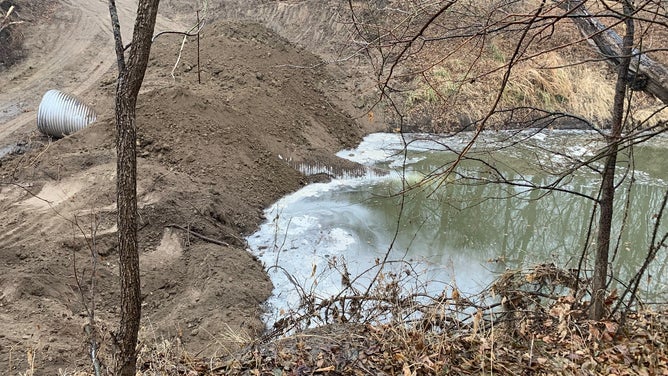Cleanup of largest oil spill in Keystone history underway in Kansas
Pipeline operator TC Energy, a Canadian-based company, said oil began releasing into Mill Creek in Washington County, Kansas, on Dec 7. The spill volume is 14,000 barrels, the company estimates. A barrel is 42 gallons, about the same volume as a typical bathtub.
Keystone Pipeline spills thousands of barrels of oil in Kansas
Crews have been working to stem a leak of thousands of barrels of oil from the Keystone Pipeline into a creek in Washington County, Kansas, that prompted the shutdown of the entire Keystone system. These satellite images, which Maxar Technologies said were captured on Saturday, show affected parts of Mill Creek.
TOPEKA, Kan. – Thousands of barrels of oil from the Keystone Pipeline have spilled into a Kansas creek, prompting a temporary shutdown of the onshore system.
Pipeline operator TC Energy, a Canadian-based company, said oil began releasing from the 2,687-mile pipeline from the Canadian heartlands to the Gulf of Mexico on Dec. 7.
Company officials estimate that roughly 14,000 barrels – enough to fill an Olympic-style swimming pool – have spilled into Kansas’ Mill Creek, located about 150 miles northwest of Kansas City. A barrel is 42 gallons, about the same volume as a typical bathtub.
HOW WEATHER IMPACTS OIL DRILLING OPERATIONS

The area impacted by the pipeline rupture and subsequent oil discharge into Mill Creek near Washington, Kansas.
(U.S. EPA)
Largest oil spill in Keystone history
On Monday, the company said that vacuum trucks and oil skimmers had recovered 2,598 barrels of oil and water from the creek, which is not connected to a drinking water source.
It's the largest oil spill in Keystone history, according to government data. A July 2021 report by the United States Government Accountability Office states there have been 22 accidents in the system since Dec. 31, 2020. Twelve of those accidents released 2 or fewer barrels, while 18 of those released fewer than 50 barrels of crude oil.
The agency said two more recent accidents account for about 93% of the total 11,975 barrels of oil released from Keystone since 2010. Both accidents occurred on the pipeline right-of-way. The first was in northeastern South Dakota near Amherst, in November 2017 and spilled 6,592 barrels. Another in northeastern North Dakota, near Edinburg in October 2019 spilled 4,515 barrels.
RESCUERS USE DISH SOAP TO SAVE OIL-SLICKED ANIMALS IN CALIFORNIA

An earthen underflow dam constructed near Washington, Kansas, to prevent further migration of oil.
(U.S. EPA)
TC Energy began operating the Keystone Pipeline System in 2010 and has transported over 3 billion barrels of crude oil from Canada to refineries in Illinois, Oklahoma, and Texas.
More than 300 people, including the Environmental Protection Agency and third-party experts, are on hand to support containment and incident response. As crews work around the clock to contain the oil from moving downstream, they have also established environmental monitoring, including around-the-clock air monitoring. The oil has not breached the containment area, according to TC Energy.
"Our primary focus right now is the health and safety of onsite staff and personnel, the surrounding community and mitigating risk to the environment," the company said in a statement.
Kansas health officials issue warning
TC Energy has built an earthen underflow dam on the creek approximately 4 miles downstream of the rupture location to prevent further oil migration, the EPA said. It includes a pipe that allows water to pass through while preventing further migration of oil.
The Kansas Department of Health and Environment has issued a Stream Advisory warning residents not to enter the creek and to keep livestock, pets and children out of the creek.
As thunderstorms moved through the region on Tuesday, TC Energy told FOX Weather that the rainfall has not impacted containment.
"Our efforts to prepare for precipitation continue to work, including a secondary dam to mitigate increased precipitation and additional onsite resources and vac trucks to manage the weather," the company said. "Rainfall in the area is impacting roads, with some vehicles getting stuck; we are bringing in more gravel, mats and limiting traffic as it allows."
Reuters reported prices for sour crude grades in the U.S. Gulf of Mexico were strengthening on Monday, as the pipeline shutdown means more demand for heavier Gulf barrels.
Oil refiners could be forced to cut production rates by Christmas week if the pipeline does not restart by then, a crude analyst told the news agency. Refiners typically hold 10 days of crude supply on hand.
The Keystone Pipeline remains shut down as ongoing efforts continue to contain and recover the oil. The EPA anticipates removal activities will extend into next week.
